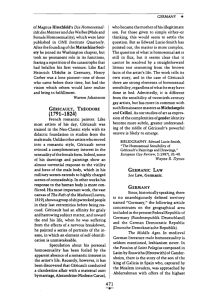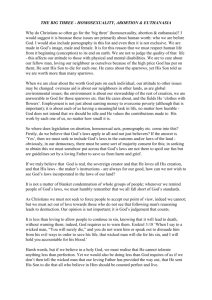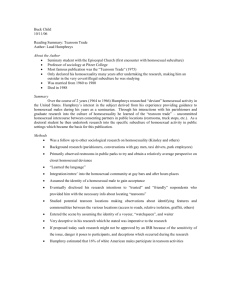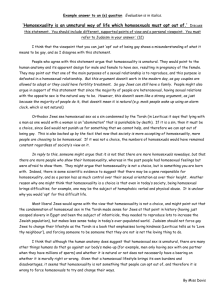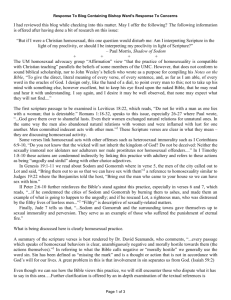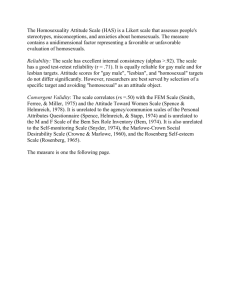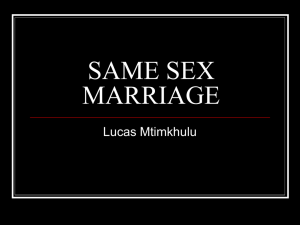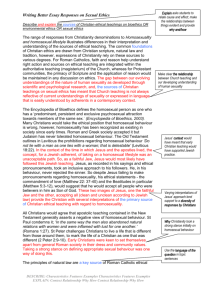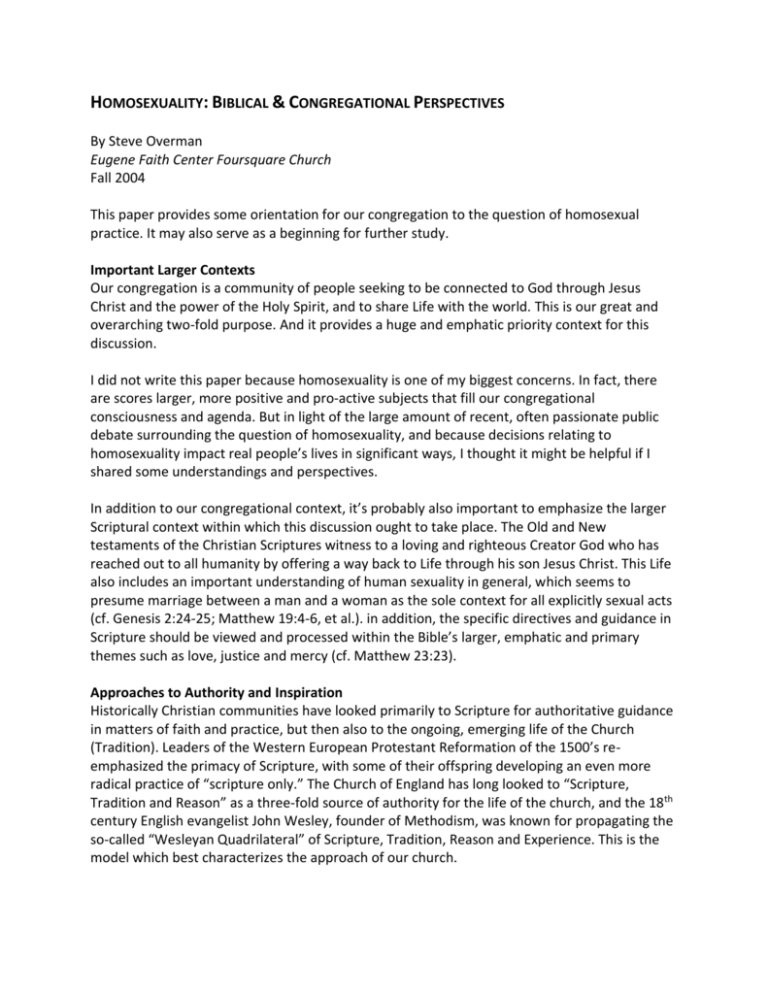
HOMOSEXUALITY: BIBLICAL & CONGREGATIONAL PERSPECTIVES
By Steve Overman
Eugene Faith Center Foursquare Church
Fall 2004
This paper provides some orientation for our congregation to the question of homosexual
practice. It may also serve as a beginning for further study.
Important Larger Contexts
Our congregation is a community of people seeking to be connected to God through Jesus
Christ and the power of the Holy Spirit, and to share Life with the world. This is our great and
overarching two-fold purpose. And it provides a huge and emphatic priority context for this
discussion.
I did not write this paper because homosexuality is one of my biggest concerns. In fact, there
are scores larger, more positive and pro-active subjects that fill our congregational
consciousness and agenda. But in light of the large amount of recent, often passionate public
debate surrounding the question of homosexuality, and because decisions relating to
homosexuality impact real people’s lives in significant ways, I thought it might be helpful if I
shared some understandings and perspectives.
In addition to our congregational context, it’s probably also important to emphasize the larger
Scriptural context within which this discussion ought to take place. The Old and New
testaments of the Christian Scriptures witness to a loving and righteous Creator God who has
reached out to all humanity by offering a way back to Life through his son Jesus Christ. This Life
also includes an important understanding of human sexuality in general, which seems to
presume marriage between a man and a woman as the sole context for all explicitly sexual acts
(cf. Genesis 2:24-25; Matthew 19:4-6, et al.). in addition, the specific directives and guidance in
Scripture should be viewed and processed within the Bible’s larger, emphatic and primary
themes such as love, justice and mercy (cf. Matthew 23:23).
Approaches to Authority and Inspiration
Historically Christian communities have looked primarily to Scripture for authoritative guidance
in matters of faith and practice, but then also to the ongoing, emerging life of the Church
(Tradition). Leaders of the Western European Protestant Reformation of the 1500’s reemphasized the primacy of Scripture, with some of their offspring developing an even more
radical practice of “scripture only.” The Church of England has long looked to “Scripture,
Tradition and Reason” as a three-fold source of authority for the life of the church, and the 18 th
century English evangelist John Wesley, founder of Methodism, was known for propagating the
so-called “Wesleyan Quadrilateral” of Scripture, Tradition, Reason and Experience. This is the
model which best characterizes the approach of our church.
While most – if not all – Christians receive the Scriptures as “inspired,” precise understandings
of what that means and how the Scripture should be read and used can vary. Some might
emphasize the divine source and nature of Scripture more than the human, while others may
do the opposite. What seems clear is that there are both divine and human elements, and our
congregation tries to take both seriously.
The Traditional View
Within the Biblical context mentioned above, the few specific references to homosexual acts in
Scripture seem to be, without exception, negative.
The similar stories of attempted male homosexual rape in Genesis 19:1-29 (see subsequent
references to the incident in Ezekiel, especially 16:49-50, Jude 7 and 2 Peter 2:6) and Judges
19:22-25 may be focused more on violence and general sexual licentiousness, but they are
likely also disapproving of the homosexual element as well.
We might also note references in the historical books to the so-called qedeshim, “homosexual
cult prostitutes,” an “abomination” (Hebrew. t’evah) that seemed to recur during periods of
unfaithfulness in Judah’s history (Deuteronomy 23:17-18; I Kings 14:21; 15:12-14; 22:46; 2 Kings
23:7).
Foundational for emergent Judaism and later for early Christian faith and practice, the
“Holiness Code” in Leviticus explicitly prohibits male sexual intercourse: “You shall not lie with a
male as with a woman; it is an abomination” (Leviticus 18:22). In Leviticus 20:13, the same act is
listed in a series of prohibited sexual acts that are punishable by death, including adultery,
incest and bestiality. Of course, the Church, with the help of God’s Spirit, must still attempt to
discern which of the Levitical directives in the Holiness Code are time- and space-specific ritual
“purity” or identity laws, and which might carry some abiding moral force and guidance.
But on the basis of this Old Testament prohibition, first century Jews apparently universally
rejected homosexual behavior. This was almost certainly the perspective of Jesus. While the
Jesus of the gospels engages with sexual “sinners” in a strikingly open way, He also calls them
to a new and different way of living, more in keeping with Life. He seems to presume His
religious culture’s strictures against all forms of porneia (“sexual immorality”) as described in
Leviticus 18 & 20. If it were not so, it presumably would have been remarkable.
Judging from the New Testament and records we have from the first few centuries, it appears
the early church also adopted the Old Testament’s teaching on matters of sexual morality,
including homosexual acts. In I Corinthians 6:9-11, the Apostle Paul includes homosexual acts in
an illustrative list of behaviors which “will not inherit the kingdom of God” – “fornicators,
idolaters, adulterers. Malakoi, arsenokoitai, thieves, the greedy, drunkards, revilers, robbers”
(6:9-10). The first italicized Greek term, malakoi, literally “soft men,” is traditionally understood
to refer to the passive partner in a male homosexual act. The term arsenokoitai, traditionally
understood to refer to the active partner in a male homosexual act, appears to combine two
Greek words taken form the Greek Old Testament translation of Leviticus 18:22 and 20:13,
“lying” (koite) and “male” (arsen). These behaviors are ones in which some of the Corinthian
believers formerly engaged. But now, in the New Creation in Christ, they have been washed,
cleansed, and freed to discontinue those acts and glorify God in their bodies.
We might also mention here that the same term, arsenokoitai, is included in I Timothy 1:10, a
list of behaviors which are said to be “contrary to sound doctrine” and not consistent with “the
glorious Gospel.”
Finally, in Romans 1:18-32, Paul offers a diagnosis of the disordered, confused human
condition. Because we have failed to acknowledge and honor God as our Creator and have
“exchanged” the pure glory of God for an impure, creaturely way, God “gave us over” to our
disordered desires: “sexual impurity” (NIV, v. 24, Greek: akatharsia) and “shameful lust” (NIV, v.
26, Greek: pathos atimios). The first example Paul gives of our disorder and confusion is lesbian
and male homosexual behavior, wherein some have “exchanged” the “natural use” for that
which is “contrary to nature” (Greek: para phusin). And, as is the case with all the listed
expressions of disorder, when we act them out, we do damage to ourselves.
Of course, the larger and more important message of Paul’s letter is that we are all affected in
different ways by this general confusion and disorder and that we can all find forgiveness,
cleansing and empowerment for newness through faith in Jesus Christ and the indwelling of the
Holy Spirit.
On the basis of these Biblical passages, read within the larger contexts mentioned above, the
historic Christian Church has directed people to refrain from homosexual acts.
The Call for New, Nontraditional Understandings
Over the past 40 years, and especially in the United States, some serious Christian scholars and
church leaders have begun to argue that the Church has gotten this wrong. They argue that we
need to update or adjust our understandings and treatment of homosexuality and make a way
for the church to affirm certain kinds of homosexual practice.
While some of these arguments contest the traditional exegesis of some of the passages
mentioned above, including the precise meaning of the terms malakoi and arsenokoitai, most
of them are hermeneutical (interpretation and application of Scripture) or theological (how we
should think about things). While it is difficult to generalize, we can say that most of the
leaders’ views of the precise nature of Scriptural inspiration and authority allow them to think
about the Biblical prohibition against homosexual behavior in a larger, historical context. For
them, while the Scriptures do provide guidance for life, because they are incarnational they
come to us through the lenses, views, and limitations of individuals who lived within particular
cultures in particular stages of development. The actual guidance offered in Scripture must
therefore be carefully discerned, judged, and applied in fresh and dynamic ways to new
situations ant times. Some then argue for inclusion of practicing homosexuals on the basis of
nature, love, human dignity/justice or even simple, pure mercy.
Very few, if any, of these scholars or church leaders would argue for the blanket acceptance of
all gay sexual activity. Unmanaged lust, promiscuity, exploitation and the like are never right,
whether gay or heterosexual. But most would like to see us make a way for self identifying
practicing “gays” who believe to live some kind of covenant life within the Church.
Congregational Understandings & Attitudes
As a congregation we would never, ever want to exclude or hurt any human being through a
wrong interpretation or application of Scripture. And this has happened in history, for example,
in the case of women in church leadership or the case of American slavery. But as we can best
tell, homosexual behavior is not original design and homosexual urges or drives are not ones
that we should act out.
It’s unclear why some people may possess or develop an inclination or drive to engage in sexual
acts with a person of the same gender. But it seems clear that some do. In such a case, I
suppose we can remember that just because we feel an inclination or drive does not mean that
we must or should act it out. In fact, we should always exercise discrimination and seek to
determine which inclinations and drives tend to Life and which do not. We are free agents who
have the power to determine how we want to live. In addition, we should all have great mercy
for one another in our struggles in this life, and seek to help one another in any way we can.
Attitudinally, I suggest we hold our understanding of homosexual practice in a humble and
provisional way, open to the Spirit who is promised to guide us into all truth (John 16:13). After
all, what religious knowledge or revelation we may think we possess, we know in part; we see
in a mirror, dimly (I Corinthians 13:9, 12).
But being humble does not prelude feeling free to express our perspectives and convictions in
the public square. We should not be bullied into an inappropriate silence or forced compliance
by some tyranny of political correctness. We should strive to make the United States a place
where all of us can freely express our points of view and where people of different religious
orientations can live in freedom and peace.
We should also actively love and “receive” all people, and not in a condescending or judgmental
way. God is the Judge of every person. Loving and “receiving” does not mean that we
necessarily agree with a person’s actions; but it does give goodness a better chance to take
place – in all directions!
In the end, we return to the larger context within which we began: As recipients and
proclaimers of the Gospel, we join with God’s voice in calling all men and women – ourselves
included! – to repentance, faith and salvation through Jesus Christ.
A prayer:
May God, by God’s Word and Spirit, continue to guide us all into the way of Life in deeper and
purer ways, through Jesus Christ our Lord. Amen.
Possibilities for Further Reading
Though I read a lot of stuff of all kinds, I am no master of popular literature – even popular
Christian literature – on the subject of homosexuality, nor of the massive and growing literature
on the history, sociology, psychology, theology, or politics of homosexuality. But I have been
able to identify and look at some of the best and most up-to-date Christian scholarship on the
subject. Hopefully, with the help of the footnotes and bibliographies in these books, you will be
able to get a good start on any further study you’d like to make.
Though to me a bit edgy in tone and argument, the most exhaustive and up-to-date explication
of the traditional view is found in Robert Gagnon’s massive “The Bible and Homosexual
Practices: Texts and Hermeneutics” (Nashville: Abingdon, 2001). Fortunately, his research is
nicely condensed in a handy volume entitled “Homosexuality and the Bible: Two Views”
(Robert Gagnon and Dan Via. Minneapolis: Fortress Press, 2003). This book also contains the
non-traditional view of Dan Via, Professor Emeritus of the New Testament at Duke Divinity
School. For a non-traditional critique of Gagnon’s perspective, see Walter Wink, “To Hell With
Gays?” (Christina Century magazine, 119.13, June 5-12, 2002, pp.32-34). For Gagnon’s
response, see Christian Century Magazine 119.17, August 14-27, pp. 40-43.
A nicer, simpler and shorter expression of the traditional view can be found in “Staying the
Course: Supporting the Church’s Position on Homosexuality” (Maxine Dunham and Newton
Maloney, editors. Nashville: Abingdon, 2003). A collection of essays from Methodist clergy and
scholars in support of the traditional view, this volume contains discussions from Biblical,
pastoral, psychological and even developing world perspectives. Richard Hays’ article, “The
Biblical Witness Concerning Homosexuality,” is one of the best, brief surveys of the Biblical
passages you can find.
Also, David L. Balch has pulled together nine good articles from both traditional and
nontraditional perspectives covering such territory as trends of the past 40 years, the current
state of scientific research and interpretation of the Scriptures in “Homosexuality, Science and
the ‘Plain Sense’ of Scripture” (Grand Rapids: Eerdmans, 2000).

